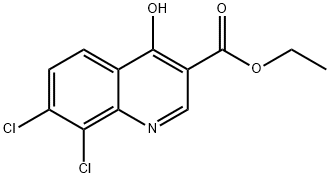Ethyl (3-chlorobenzoyl)acetate
Synonym(s):3-Chloro-?-oxobenzenepropanoic acid ethyl ester;Ethyl 3-(3-chlorophenyl)-3-oxopropanoate
- CAS NO.:33167-21-4
- Empirical Formula: C11H11ClO3
- Molecular Weight: 226.66
- MDL number: MFCD03424810
- SAFETY DATA SHEET (SDS)
- Update Date: 2023-10-19 15:27:09

What is Ethyl (3-chlorobenzoyl)acetate?
The Uses of Ethyl (3-chlorobenzoyl)acetate
Reagent / reactant involved in:• ;Oxidative cross-coupling via dioxygen activation with indoles1• ;Chlorination and hydrosilylation for synthesis of α-hydroxy β-amino acid derivatives2• ;Precursor for substrates for chiral Lewis base-catalyzed stereoselective reduction with trichlorosilane and water3• ;Intramolecular cyclization for synthesis of dihydrofurans4• ;Rate acceleration of Michael reactions5• ;Cerium ammonium nitrate-mediated oxidative coupling6
The Uses of Ethyl (3-chlorobenzoyl)acetate
Reagent / reactant involved in:
- Oxidative cross-coupling via dioxygen activation with indoles
- Chlorination and hydrosilylation for synthesis of α-hydroxy β-amino acid derivatives
- Precursor for substrates for chiral Lewis base-catalyzed stereoselective reduction with trichlorosilane and water
- Intramolecular cyclization for synthesis of dihydrofurans
- Rate acceleration of Michael reactions
- Cerium ammonium nitrate-mediated oxidative coupling
Synthesis
141.6 g of diethyl carbonate was dissolved in 1000 mL of a 1:1 ethanol-tetrahydrofuran (THF) solution, and 12.4 g of catalyst 1 Amberlite IRA-400 was added while stirring. The mixture was then heated up to 45 °C. In a separate container, 154.5 g of m-chloroacetophenone was dissolved in 1000 mL of the above-mentioned ethanol-THF mixed solvent. The addition of m-chloroacetophenone was completed within 1 hour, and stirring was continued for 6 hours. The mixture was then filtered. The filtrate was combined and the majority of the solvent was evaporated. 1500 mL of water was added to the remaining solution while stirring. The solution was then subjected to CH2Cl2 extraction, followed by washing with saturated saline until the solution reached a neutral pH. The resulting solution was dried with anhydrous MgSO4, filtered, and the solvent was evaporated. Finally, the resulting residue was distilled under reduced pressure to obtain a colorless oily liquid known as Ethyl (3-chlorobenzoyl)acetate.
Properties of Ethyl (3-chlorobenzoyl)acetate
| Boiling point: | 257-258 °C (lit.) |
| Density | 1.213 g/mL at 25 °C (lit.) |
| refractive index | n |
| Flash point: | >230 °F |
| storage temp. | Sealed in dry,Room Temperature |
| pka | 9.91±0.46(Predicted) |
| CAS DataBase Reference | 33167-21-4(CAS DataBase Reference) |
Safety information for Ethyl (3-chlorobenzoyl)acetate
Computed Descriptors for Ethyl (3-chlorobenzoyl)acetate
New Products
Tert-butyl bis(2-chloroethyl)carbamate (S)-3-Aminobutanenitrile hydrochloride N-Boc-D-alaninol N-BOC-D/L-ALANINOL N-octanoyl benzotriazole 4-Hydrazinobenzoic acid 3,4-Dibenzyloxybenzaldehyde Electrolytic Iron Powder 1,1’-CARBONYLDIIMIDAZOLE R-2-BENZYLOXY PROPIONIC ACID 4-HYDROXY BENZYL ALCOHOL 1,1’-CARBONYLDI (1,2-4 TRIAZOLE) S-2-CHLORO PROPIONIC ACID (2-Hydroxyphenyl)acetonitrile 4-Bromopyrazole 5-BROMO-2CYANO PYRIDINE 5,6-Dimethoxyindanone 5-broMo-2-chloro-N-cyclopentylpyriMidin-4-aMine 3-(Hydroxymethyl)benzoate N-Boc-2-chloroethylamine 1-Bromo-2-methoxy-3-nitrobenzene N-Methyl-3-cyclopenten-1-amine 2-Bromo-3-hydroxybenzaldehyde 1H-indazole-5-carboxamideRelated products of tetrahydrofuran








You may like
-
 ethyl 3-(3-chlorophenyl)-3-oxopropanoate 95% CAS 33167-21-4View Details
ethyl 3-(3-chlorophenyl)-3-oxopropanoate 95% CAS 33167-21-4View Details
33167-21-4 -
 7441-43-2 98%View Details
7441-43-2 98%View Details
7441-43-2 -
 1260741-78-3 6-Bromo-3-iodo-1-methyl-1H-indazole 98%View Details
1260741-78-3 6-Bromo-3-iodo-1-methyl-1H-indazole 98%View Details
1260741-78-3 -
 4-bromo-3,5-dimethylbenzenesulfonyl chloride 1581266-79-6 98%View Details
4-bromo-3,5-dimethylbenzenesulfonyl chloride 1581266-79-6 98%View Details
1581266-79-6 -
 2490430-37-8 98%View Details
2490430-37-8 98%View Details
2490430-37-8 -
 N-(5-Amino-2-methylphenyl)acetamide 5434-30-0 98%View Details
N-(5-Amino-2-methylphenyl)acetamide 5434-30-0 98%View Details
5434-30-0 -
 124371-59-1 98%View Details
124371-59-1 98%View Details
124371-59-1 -
 53857-52-2 98%View Details
53857-52-2 98%View Details
53857-52-2